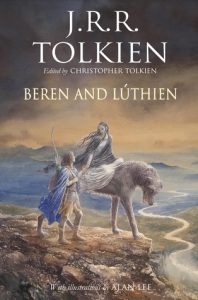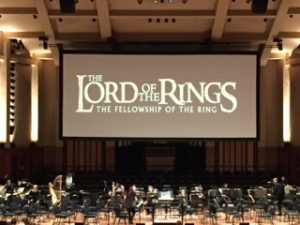So since I have this lovely new Beren and Luthien book to go through, it seemed to me that before I dive into it, it would behoove me to remind myself of the version of the tale I’m most familiar with: i.e., the one that appears in The Silmarillion. Which, of course, means that it’s TOTALLY time for a re-read of same!
(By which I mean, I’m just going to read it again–not actually do a Reread series of posts–at least for now. I may change my mind later! Persons who want to argue in favor of me doing a formal Silmarillion Reread, you are welcome to do so. I may hold on this though until I can score a French edition!)
I’ve just barely started but here are a few things I have been reminded of, or never really noticed before, now that I’m going through the book again:
- My ebook edition has additional intro sections that do not appear in my paperback: “Preface to the Second Edition”, and “From a Letter by J.R.R. Tolkien to Milton Waldman, 1951”. The Preface, which is dated 1999, is Christopher Tolkien discussing why he felt it appropriate to include the letter. And the letter itself is the one which, it turns out, includes this wonderful quote: “I would draw some of the great tales in fullness, and leave many only placed in the scheme, and sketched. The cycles should be linked to a majestic whole, and yet leave scope for other minds and hands, wielding paint and music and drama.” This is the very quote Dara and I have noted before as an argument in favor of Tolkien totally intending his world to be a mythos to which other people could eventually contribute. It’s delightful to see it here.
- There is a female equivalent of “Vala” (singular) and “Valar” (plural): “Valië” and “Valier”. I see “Valier” getting used exactly once in the initial chapters, so this is very easy to overlook. My amusement here though is that after several consecutive years of studying French, I totally want to pronounce “Valier” like a French verb.
- There isn’t much in the way of character development for any of the Valar, but hey, that’s okay, we’re operating at a mythic and epic level in the opening chapters, so it’s difficult to zoom in on specific characters. I am nonetheless amused at Aulë and Yavanna arguing about his creation of the Dwarves.
- For that matter, I’m amused once again at Aulë jumping the gun and making the Dwarves before he had any actual authority to do so. He’s all “Hey Eru I made these guys because I love you and want to be like you and also I wanted some friends OH SHIT Eru is mad should I smash them?” And Eru realizes Aulë’s not actually trying to be malicious, so he lets him keep the Dwarves, only with the caveat that they don’t get to really wake up and exist until after Elves and Men have shown up.
- So really, the TL;DR version of the entire Middle-Earth mythos boils down to “Eru and all his angels had a giant jam session, only Melkor got pissy because he wanted a solo”.
- There are more named female characters actually doing things even in the opening stretches of this thing than I remembered. Yavanna and Varda both have on-camera action, Yavanna creating the Two Trees and Varda lighting all the stars. Mélian meets up with Thingol. And we even get a passing mention of Nerdanel, the spouse of Fëanor, who at least at first was the only person capable of restraining his more asshole-ish impulses.
- Nonetheless, Fëanor? Any way you slice it, total asshole. I mean, dude, c’mon. We get that you’re proud of your Shiny Holy Jewels and your artistic accomplishment, but Yavanna is asking you to your face if she can use them to resurrect the Two Trees. Which are the original source of the light you put into your Shiny Holy Jewels to begin with. And that’s only Fëanor just getting started on being an asshole.
- Galadriel! Ten chapters in and she’s not getting much in the way of on camera action, but she is totally there, and called out by name alongside her brothers. Note is made that her branch of the Noldor hang back from the Kinslaying, but Galadriel totes wants to go back to Middle-Earth and have her very own little realm to rule.
- I learned a new word: coëval. Which apparently means “contemporary to/the same age as”, and it’s used in describing Melkor in relation to Manwë. Because even after all this time I can still notice new words when reading Tolkien. <3
The ebook’s got some formatting issues for chapter titles, which is a bit irritating; I may have to crack into the ebook and fix those titles, just for my personal reading satisfaction.
Also, given that I’m about to go to Quebec next month, I may have to see if I can hunt down a French translation! Because I have French translations now of both The Hobbit and The Lord of the Rings, so clearly I need one of The Silmarillion for my collection. 😀



